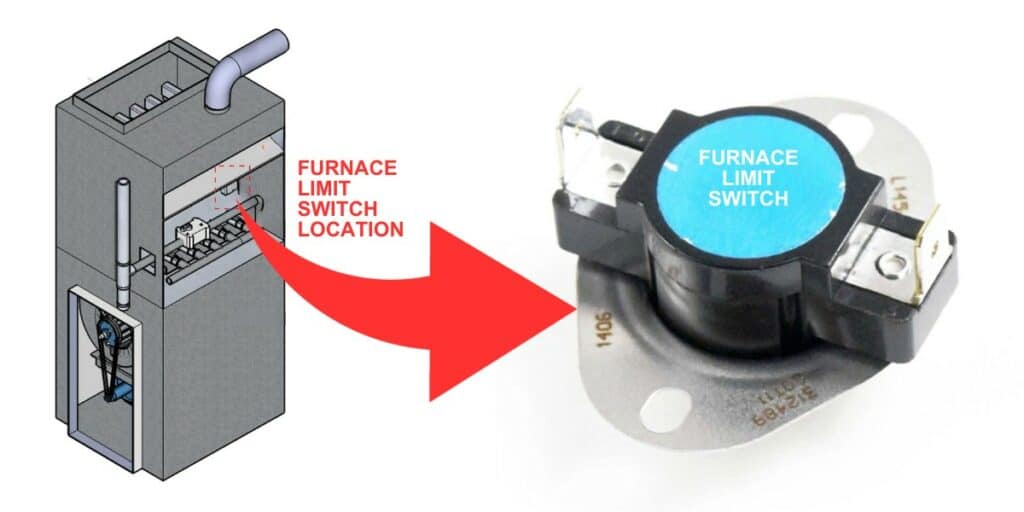Dealing with a furnace that frequently shuts down can be frustrating. Often, this issue is linked to a problem with the limit switch, a critical component in ensuring your furnace operates safely and efficiently. This guide will walk you through replacing a furnace limit switch, helping you restore your furnace to optimal working conditions.
What is a Furnace Limit Switch?
A furnace limit switch is a safety device within your furnace that plays a crucial role in monitoring and controlling the internal temperature. Its primary function is to shut off the furnace if the internal temperature becomes dangerously high, thereby preventing overheating and potential hazards.
| Switch Type | Fan Limit Switch | High Limit Switch |
|---|---|---|
| Function | Controls the blower fan, turning it on or off based on the furnace’s internal temperature. | Prevents the furnace from overheating, playing a crucial role in safety. |
| Location | Typically found in the plenum, the large space at the top of the furnace where ductwork begins. | Situated at the top of the combustion chamber, just above the heat exchanger. |
| Operation | Normally open and closes to activate the blower when the plenum fills with warm air. Prevents the furnace from blowing cold air and stays closed until the temperature drops to a predefined set point. | Measures the air temperature inside the plenum. Turns off the gas supply when the temperature exceeds its set point, thereby preventing overheating, potential cracks in the heat exchanger, and the release of toxic gases like carbon monoxide. |
In many modern furnaces, these two limit switches are combined into a single unit that performs both functions. This combination switch is more efficient and compact, simplifying the furnace’s design and operation.

When functioning correctly, the limit switch operates seamlessly in the background, balancing comfort and safety. It prevents the furnace from distributing cold air, ensuring efficient heating, and at the same time, acts as a crucial safety barrier against overheating and potential fire hazards.
A malfunctioning limit switch can lead to various issues:
- If the fan limit switch gets stuck in the open position, the blower won’t activate, causing the furnace to overheat.
- Conversely, if it sticks in the closed position, the blower will continue running, pushing cold air into your home.
- A faulty high-limit switch might trigger too often due to overheating or could be defective, prematurely shutting off the gas supply.
Identifying and accessing the limit switch is the first step in the replacement process.
Step-by-Step Guide to Replacing the Limit Switch
Dealing with furnace issues can be daunting, but some tasks, like replacing a limit switch, are manageable DIY projects. Our detailed guide aims to simplify this process for you. With the right tools and patience, you can successfully replace a furnace limit switch, ensuring your furnace runs safely and efficiently. Follow these steps to guide you through each stage of the replacement process.
Now, let’s proceed with the step-by-step instructions for replacing the limit switch in your furnace.
1. Accessing the Furnace Interior
- Tools Needed: Phillips screwdriver (for older models) or just your hands (for newer models with plastic knobs).
- Process: Remove the front cover of the furnace to access the internal components.
2. Identifying the Limit Switch
- Location: Near the top of the burner assembly, distinguishable from the flame sensor by its position and wiring.
- Inspection: Check if the reset button on the limit switch is popped out. If so, pressing it might solve your problem without needing a replacement.
3. Performing a Limit Switch Test
- Tools Needed: Multimeter set to read DC voltage.
- Procedure: Test the terminals on the limit switch. A voltage drop greater than 0.2 VDC indicates a faulty switch.
4. Power and Gas Supply Shut-off
- Safety First: Turn off the furnace’s power supply and gas line to ensure a safe working environment.
5. Disconnecting the Old Switch
- Tip: Use your mobile device to photograph the wire leads for easy reconnection later.
- Removal: Disconnect the wires from the switch, typically held on with spade connectors.
6. Removing and Replacing the Switch
- Unscrew the old switch and replace it with an identical new one, securing it firmly in place.
- Reconnect the wires as per the photograph taken earlier.
7. Reassembling the Furnace
- Replace the furnace cover, securing it with screws or knobs as required.
8. Testing the Furnace
- Restart the furnace and test it by setting the thermostat to a high temperature.
Symptoms of a Faulty Limit Switch
A properly functioning limit switch is essential for your furnace’s safe and efficient operation. However, like any mechanical component, it can experience wear and tear over time, leading to malfunction. Recognizing the signs of a faulty limit switch is key to addressing issues early and avoiding more significant problems.
Here are some common symptoms to watch out for:
- Inconsistent Furnace Cycling
- The furnace turns on and off more frequently than usual, a condition known as short cycling. This could be due to the high-limit switch tripping too often, possibly because of overheating or a faulty switch.
- Furnace Overheating
- The furnace becomes excessively hot, or you may notice a burning smell. A malfunctioning high-limit switch may fail to turn off the gas supply when the temperature exceeds safe limits, leading to overheating.
- Continuous Blower Operation
- The blower fan runs non-stop, even when the heating cycle is complete. This can occur if the fan limit switch gets stuck in the closed position, failing to signal the blower to turn off.
- No Heat or Insufficient Heating
- The furnace fails to produce heat, or the heat output is significantly reduced. A faulty fan limit switch might prevent the blower fan from activating, leading to inadequate heat distribution.
- Frequent Safety Trips
- The furnace frequently enters a safety shut-off mode or lockout condition. Repeated tripping of the high-limit switch due to overheating can cause the furnace to enter a lockout state for safety reasons.
- Furnace Blows Cold Air
- If the fan limit switch malfunctions, it may activate the blower prematurely, circulating cold air through the house.
- Unresponsive to Thermostat Changes
- The furnace doesn’t respond correctly to thermostat adjustments. A faulty limit switch can disrupt the normal operation of the furnace, making it less responsive to thermostat controls.
Identifying these symptoms early can help prevent further damage to your furnace and ensure a comfortable and safe environment in your home. If you notice any of these signs, it’s important to conduct a thorough check or consult a professional for a detailed inspection and appropriate repairs. Regular furnace maintenance can also help detect and resolve limit switch issues before they escalate.
Choosing the Right Replacement Switch
Select a limit switch that matches your furnace’s make and model. Look for the model number located on the rating plate of the unit. While universal switches might seem cost-effective, compatibility with your specific furnace model is key to ensuring proper functionality.
How much does it cost to replace a furnace limit switch?
A new limit switch’s price varies, typically from $10 to $25. If you opt for professional installation, the total cost, including labor, can be between $150 to $400.
Replacing a furnace limit switch can be a straightforward DIY task if approached methodically and with the right tools. However, it’s wise to consult a professional if you’re unsure about any step in the process or if the issue persists. Regular furnace maintenance can also help in preventing such issues in the first place.






